For a long time, we have been focusing a lot on the hardware costs of new processors but missing the virtualization license costs. Part of that is simply due to the number of virtualization licenses and support models. Recently, we purchased the most popular barebones server and the most popular server processor on Newegg to see what they offered. That sparked a discussion in the team about saving money on licensing and has spawned maybe not a new series but a new line of content at STH that you will see over the coming weeks. Let us get into it.
The video associated with this piece is here:
We always suggest opening the video in its own browser, tab, or app for the best viewing experience. We also need to thank AMD for sponsoring this so we could get the parts we needed. We also had parts from HPE, Supermicro, Gigabyte, and others, so we need to acknowledge that, too.
How We Got Here: The Gigabyte R113-C10 Barebones Combo
This series kicked off with a simple concept. I went to Newegg (for our international audience, this is an old and popular online computer retailer) and simply looked for the best selling server CPU. It ended up being the AMD EPYC 4464P, a 12 core/ 24 thread processor from the EPYC 4004 series.
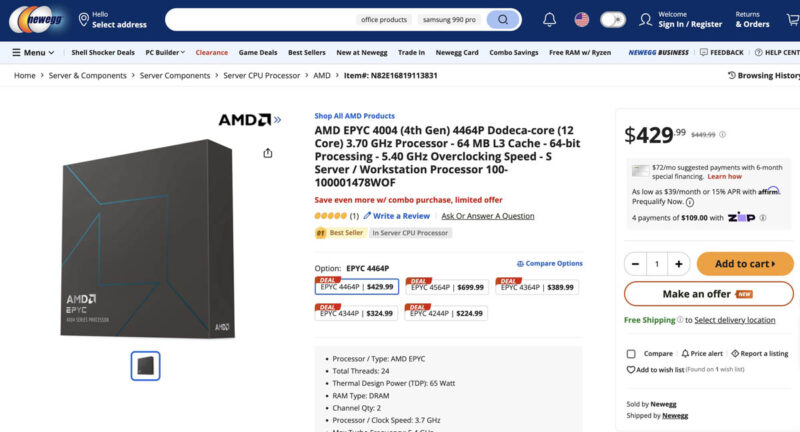
A few minutes later, the next question is what about a barebones server to put one in. That led me down the path of looking for the best selling server barebones, which happened to be the Gigabyte R113-C10 with the AMD EPYC 4464P already installed. When we purchased this over a month ago, it was an $899 combo (now $925) with free shipping. That was for a server that is $633 and a CPU that costs $429 for about a 15% combo savings.
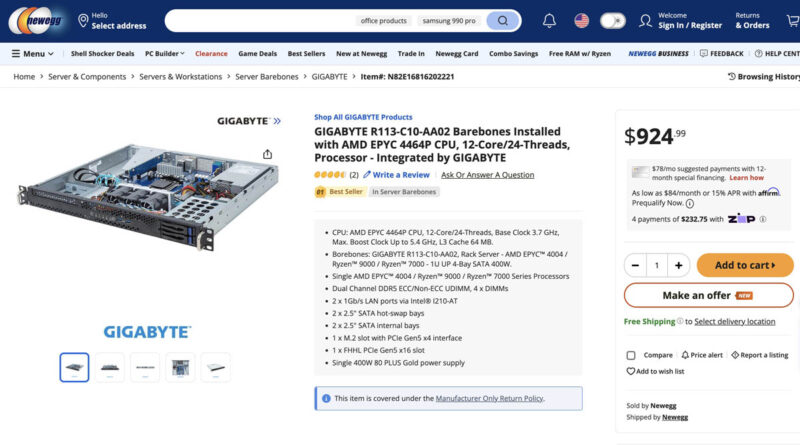
Once it arrived, we fitted it with 96GB and also 192GB configurations. That 192GB (4x 48GB) got us thinking that this was an exceptional virtualization platform.
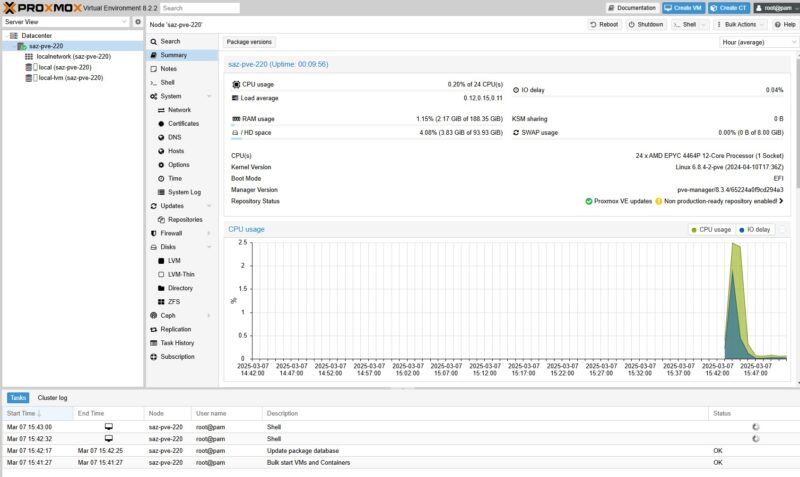
Once we had this running, the talk inside the STH team was that the AMD EPYC 4464P and the 16-core EPYC 4004 parts were much better optimized for virtualization applications. That sent us down a path of looking at the entire stack. What started as looking at a single low-cost system, which we will review in the future, ended up getting into just how much newer processors offer. We often discuss 10-15% generational improvements, or the “more cores, more better” of server consolidation but we have not looked at the dimension of server licensing costs in a long time.
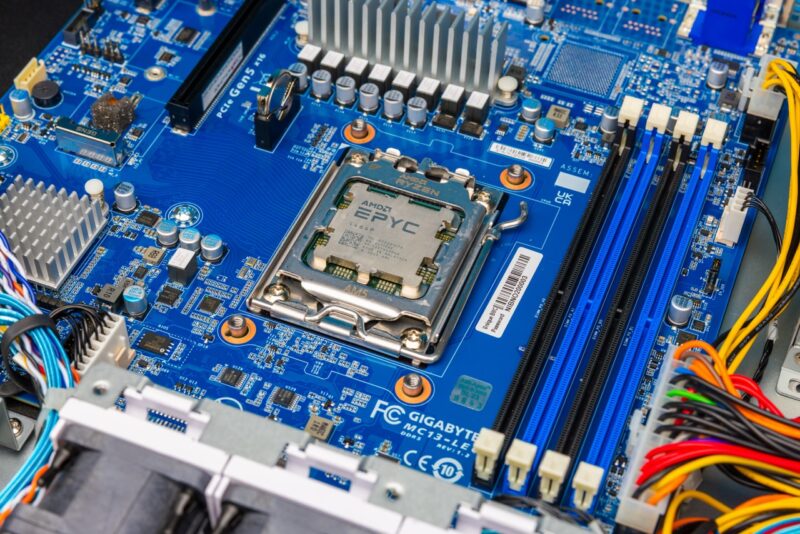
It was time to get into that.
Virtualization License Cost 101
Server licensing is a complex topic since so many applications and features have different types of licensing and support models. There are entire firms dedicated to navigating that. Still, here is a quick table on some of the basic server licensing models ranging from “Free” open source DIY options to various ways to optimize server architectures to the licensing vectors.
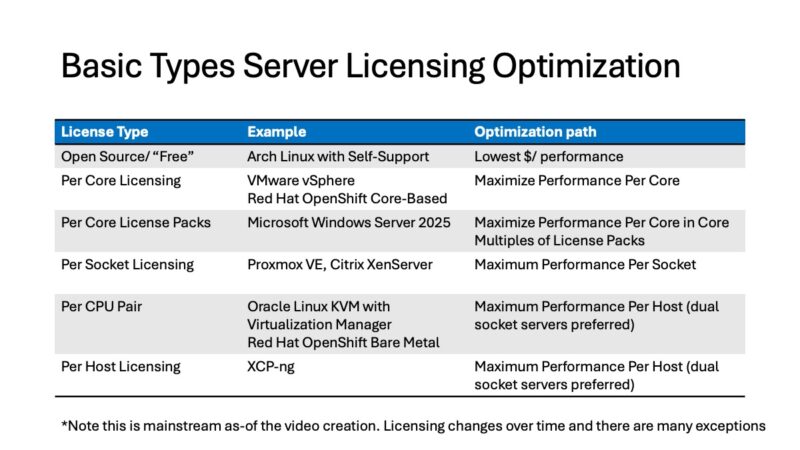
The above table is very important. If you want to know why cloud-native Arm server CPUs as well as the Intel Xeon 6700E/ 6900E line have struggled, a CPU core is almost always defined as a CPU core with SMT threads included. Maximizing the performance per core often means huge gains in license cost savings. Instead of simply maximizing the number of cores in a system, what folks often do instead is try to maximize the amount of compute that is covered by the licensing model of the software they want to run.
There are hundreds of different server CPU SKUs deployed today, so here is a quick sample that we are going to use to illustrate some points. We are also going to use SPECrate2017_int_base scores as our official metric here since it is widely adopted in the industry. There are many other metrics, but hundreds of CPUs and hundreds of performance metrics becomes messy quickly, so we wanted to get to a simplified view.
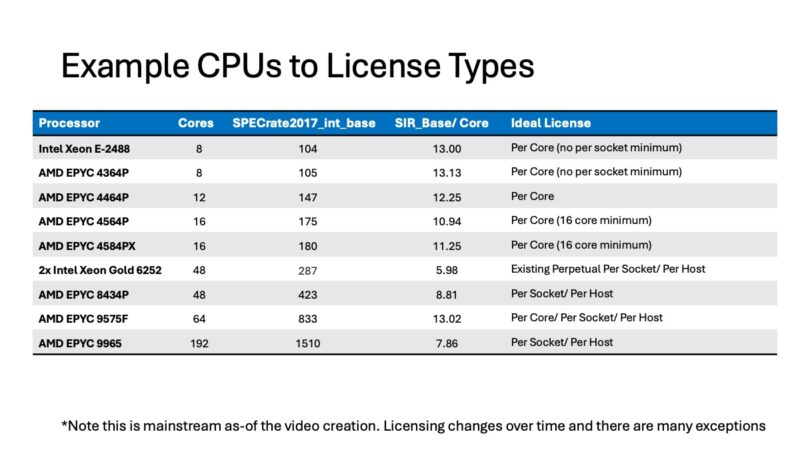
When it came to the AMD EPYC 4464P, perhaps it makes sense why it is popular. It offers 12 Zen 4 cores and 24 threads at a low cost and low power consumption footprint. The 65W TDP CPU running 192GB of memory and with five SSDs installed was running at under 150W maximum under 100% load. In a typical virtualization setting with 70-80% utilization, this is right at the 120W per U that was used for many legacy racks found in colocation and lower-density data center racks.
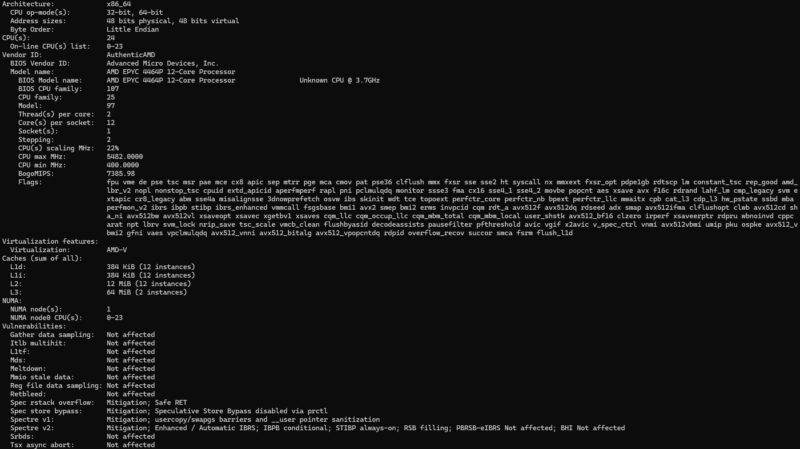
Aside from having a power consumption profile that fits well in that low power density rack profile, the performance is quite good. Intel and AMD are very close when it comes to SPECrate2017_int_base performance at 8 cores, but the Intel Xeon E-2400 series and Xeon 6300 series are limited to 8 cores while AMD continues to scale to twice that figure. A product of having more cores is that the AMD EPYC 4464P and the 16-core EPYC 4565P and 3D V-Cache EPYC 4585PX SKUs offer a lot more performance in the same platform.
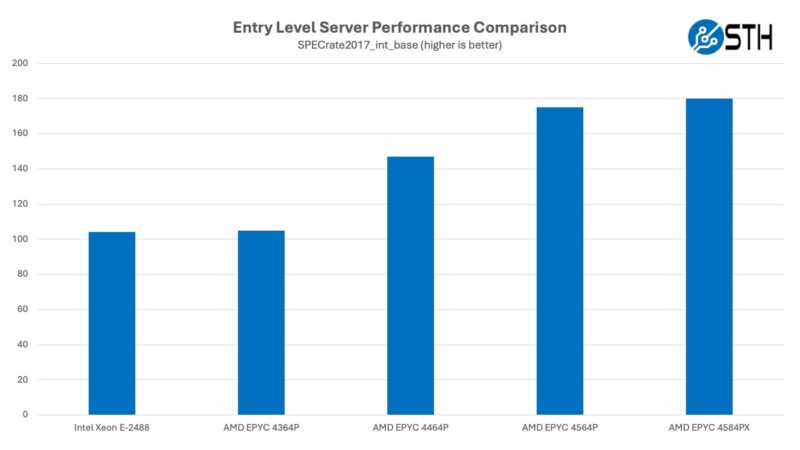
If we just cared about per socket performance, then the 16 core and 12 core EPYC 4004 SKUs offer a lot. Both also fit neatly into the Microsoft Windows Server 2025 licensing 16-core packs. If you cared solely about core counts, then these would be extreme values in the licensing space. Of course, we also generally want high performance per core, and that is usually where these entry-level server CPUs excel. That makes them often used for EDA servers, web hosting servers, and even dedicated gaming servers. When we look at the performance per core, the EPYC 4464P has a fairly minimal drop-off compared to the 8 core parts, but even the 16 core parts are in the same ballpark of performance per core.
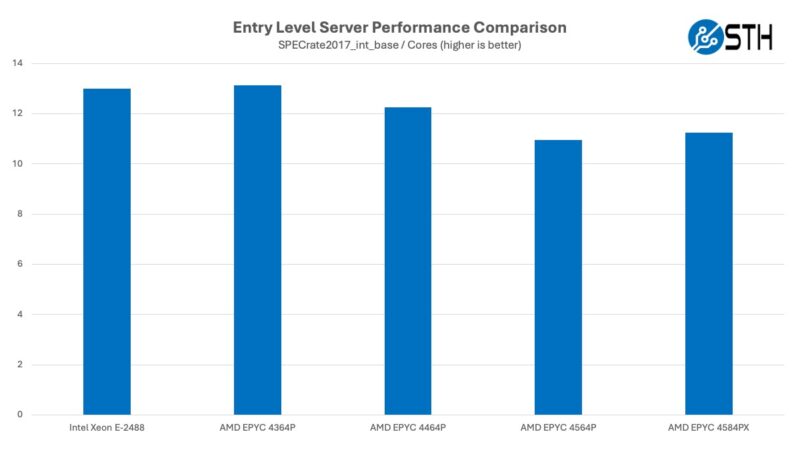
Of course, that is great, but the entry-level server market is small. We wanted to look at how this scales to higher-end parts. As such we are using our standard baseline of the dual Intel Xeon Gold 6252 that we started using as part of our cloud-native series in 2024. We picked those parts based on two factors. First, depending on who you ask, 1st Gen/ 2nd Gen Intel Xeon Scalable (Skylake) which were top of the line from 2017-2021 make up something like half of the installed base. Second, we asked Supermicro what their most popular 2nd Gen Xeon SKU sold was, and they said the Xeon Gold 6252. Those are 24 core parts that Intel discounted heavily since the AMD EPYC 7002 “Rome” came on the scene in 2019 with 64 cores. Taking a look at a few SKUs that we reviewed recently from Intel and AMD, we have this chart for SPECrate2017_int_base:
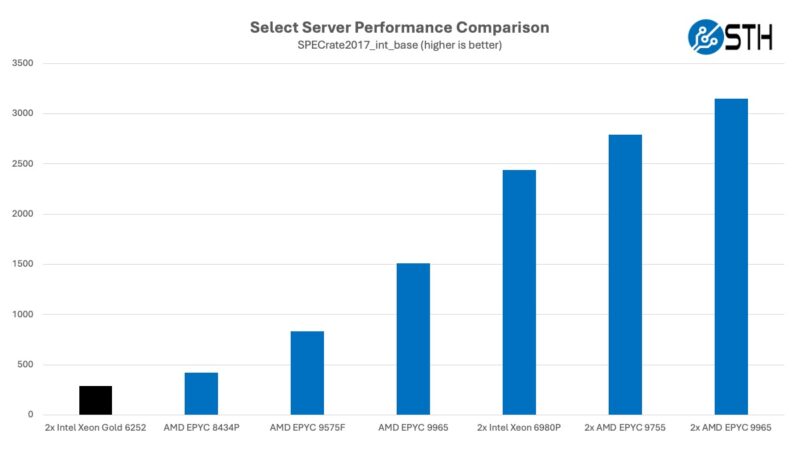
One of the coolest things here is that the AMD EPYC 8434P in the HPE ProLiant DL145 Gen11 we reviewed was hitting around 300W at the PDU (it would be a bit more in a SPEC CPU2017 official run scenario.) Still AMD’s single-socket edge compute platform was delivering more performance in the same core count while consuming less power.
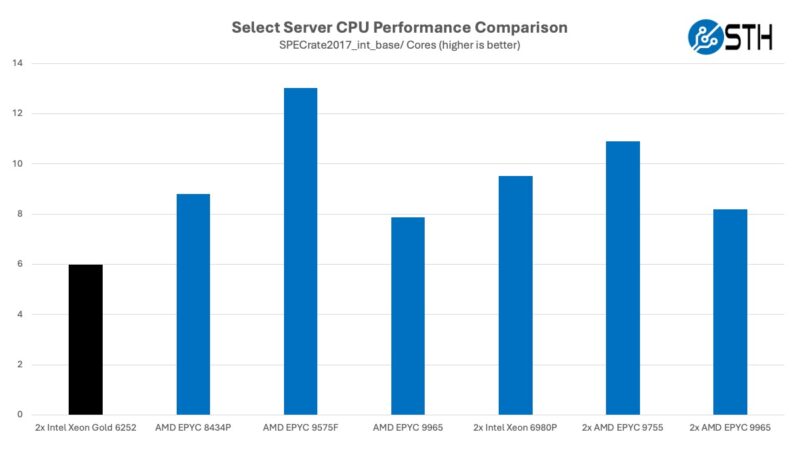
Scaling up the performance per socket is trivial as the EPYC 9005 (and 9004) series has a range of options. That can mean the AMD EPYC 9965 that offers not just over 12x the performance, but does so even at a roughly 33% higher performance per core clip over the Xeon Gole 6252 baseline. A common refrain we get comments on is that the 192 core parts are great, except for per-core licensing. It turns out, you can not only get more value from a per core license, but you can also do massive server consolidation projects. We will even have a neat way to use the servers for AI coming in the next few days.
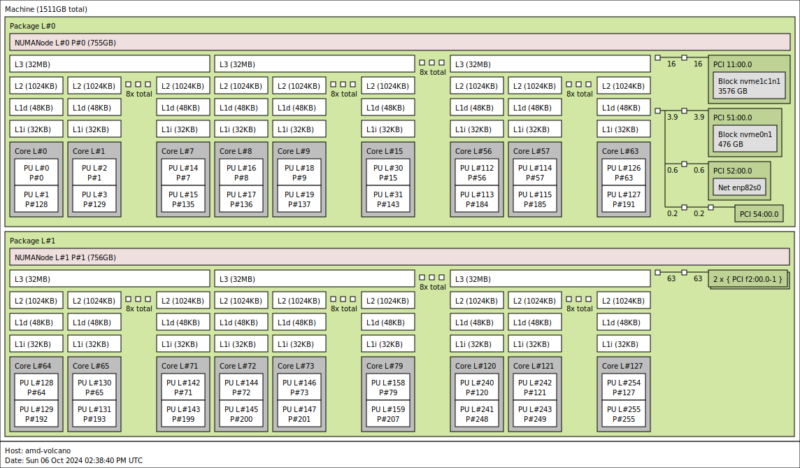
Beyond that, the AMD EPYC 9575F may look mundane at first, but with 64 cores, it is in that same ~13 SPECrate2017_int_base score per core, just like the 8-core entry server products. For the last decade or so, the common wisdom has been that as you scale out to more cores, the clock speeds decrease along with performance. Generations of STH readers have seen that the choice was low core count server CPUs for per core performance or high core count server CPUs for per socket and per server performance. That EPYC 9575F makes it so it is no longer a trade-off. If you are in the new VMware per-core virtualization licensing regime, or pay for Microsoft Windows Server licensing, getting more than twice the performance per-core of the common CPUs in data centers today, also translates into fewer sockets and servers.
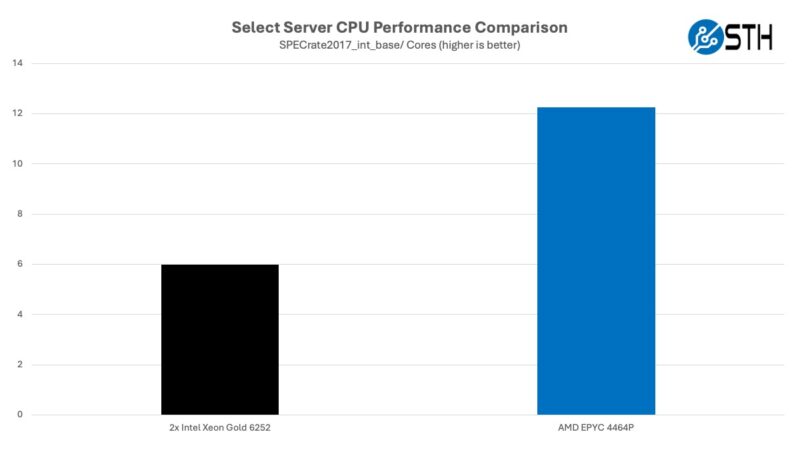
Tying this together, here is a fun view. The AMD EPYC 4464P at 12 cores offers more than twice the performance of the Xeon Gold 6252. One can half the core counts using low-cost servers and have a quick payback once most licensing regimes are taken into account. The story is likely better with the 16 core parts, but there must be a reason this is the most popular option on Newegg.
Still, there is another aspect that AMD does not highlight, but we found since we have so many systems being tested right now. We will get to that next.



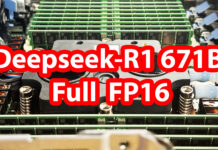
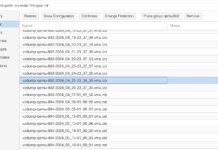
Can we get a review of the GB system? That looks neat.
We’ve got a 512 2P Xeon virtualization cluster that we’ll transition in 2H. You’re right the licensing costs more than the hardware.
Great charts! STH always has an excellent perspective. I’d like to learn more about that server too
Since VMware came out with the per core licenses I’ve bought processors in line with those licensing bands. I will have to look at buying AMD Epyc next go around with performance being that much better.
Supermicro AS -1015A-MT has better cooling and 2 x M.2 NVME
MS Server comes with 16 core license to begin with. If you need more than that they sell them in 2 core and 16 core packs for sure. Do note that Server Standard only allows for 2 VMs where as Datacenter allows for unlimited VMs. Plus if you desire 4 servers at 16 cores each it costs the same as 2 servers with 32 cores each.
@Bob
I know that all too well. We are in the final stages of an upgrade and the VMware licensing was 1/2 of our budget since it is now per core.
@Jason
The Epyc CPUs have been very nice for a while. Before VMware went to the per core license model they were doing a 32 core license model. Basically every license was for 32 cores and if you had say dual 64 core CPUs you needed 4 licenses. At one point in time it was a “waste” of a license to do anything less than 32 CPUs as you weren’t using the full license amount and Intel topped out at 40 cores.
While there is no denying the reality, I personally find per-core licensing without regard to core strength to be weird. I also think such licensing is what led to those maladaptive IBM Power cores with 8-way SMT.
If a licensing model does not take into account the shift in Moore’s law from frequency scaling to multiple cores and as a result actively discourages the power savings obtained from running more cores at slower clocks, what kind of race to the bottom is that?
Hi Patrick… Did you know HPE recently introduced our offer for virtualization – HPE VM Essentials, based on the Morpheus Data platform. It can managing both existing VMware VMs and offers the ability to migrate workloads to the KVM based HPE VM hypervisor.
We’ve licensed it per socket…
Nice to mention XCP-NG, but unless you need support, it is free of charge and fully open-source.
I found this hilarious. It also supports my alt theory that “the cloud” mostly exists because IT joes are mostly terrible at math and or analytics.